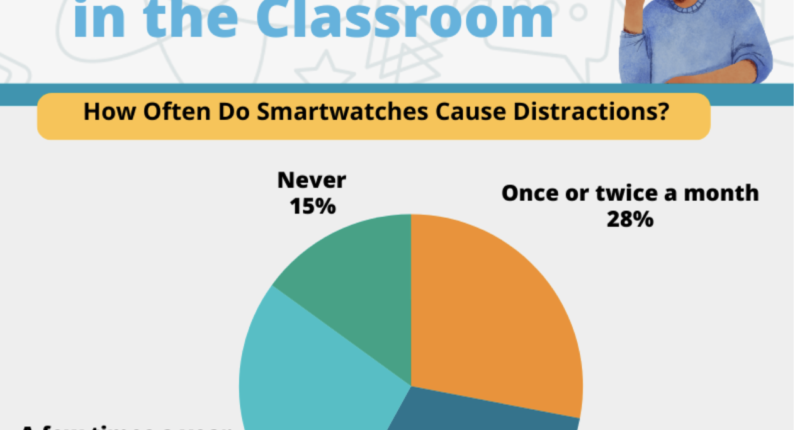Written By Khristian Mecom and Alina Lehtinen-Vela
With many middle and high school students expected to receive smartwatches as gifts this holiday season, teachers are anticipating a wave of new disruptions to hit classrooms in the new year. According to a Study.com survey of 700 teachers in schools with universal cell phone bans, 70% of respondents believe those smartwatches received as holiday gifts will lead to increased distractions in the classroom.
Wearable technology is often used as a substitute for cell phones. In fact, 50% of teachers report they are noticing a trend of students using smartwatches instead of cell phones during class. The uptick in smartwatch usage among students follows the implementation of cell phone bans in many school districts across the US. While these bans might have been effective in reducing one type of distraction, they may have inadvertently paved the way for new challenges in the form of wearable tech.
Key Takeaways
- 50% of teachers say smartwatches are becoming a substitute for cell phones in classrooms
- 70% of teachers believe wearables received as gifts will contribute to increased distractions after the holidays
- 45% of teachers have already overheard students discussing plans to receive smartwatches as holiday gifts, signaling a likely surge in wearable usage
- 40% of teachers noticed an increase in smartwatch usage since cell phone bans were implemented
- 60% of teachers cite texting as the top issue caused by smartwatches, and 60% report students playing on the devices instead of focusing on lessons
- 53% of teachers say smartwatches make it easier to cheat compared to other devices
 |
Holiday Season and Smartwatch Surge
As cell phone bans in schools become more common, parents’ concerns about staying connected with their children during the school day have grown. According to Study.com’s teacher cell phone ban survey, teachers shared that parents’ top concerns include the inability to reach their children during the school day and challenges with communication during emergencies.
Companies selling smartwatches are targeting parents this holiday season by emphasizing features such as emergency communication and location tracking. It’s no surprise that teachers in our survey have noticed more conversations around smartwatches and are wary of the impact the uptick in wearables as holiday gifts will have.
- 70% of teachers believe wearables received as gifts will contribute to increased distractions after the holidays
- 45% of teachers have already overheard students discussing plans to receive smartwatches as holiday gifts, signaling a likely increase in wearable usage
- 54% of teachers expect increased pushback from parents if wearable bans are enforced after students receive smartwatches as gifts
The Growing Impact of Smartwatches
Many educators worry the constant connectivity of smartwatches will bring new challenges to classroom management. Unlike cell phone bans, there is no unified wearable technology policy that school districts consistently follow:
- 33% of teachers report that wearables are banned only during class time
- 31% of teachers state that wearables are allowed at all times
To better understand how teachers are contending with smartwatches in the classroom, the survey asked about their top concerns.
Smartwatches as Substitutes for Cell Phones
Teachers worry that smartwatches are simply replacing banned cell phones, leading to the same types of classroom issues and disruptions.
- 50% of teachers report that smartwatches are replacing cell phones in the classroom
- 40% of teachers noticed an increase in smartwatch usage since cell phone bans were introduced
Distraction Concerns
Smartwatches have most of the same capabilities as smartphones, including access to messaging apps, social media apps, and mobile games.
- Nearly 30% of teachers report experiencing daily or weekly distractions from smartwatches
- 60% cite texting as the top issue posed by smartwatches, followed by 60% who report students playing on devices instead of focusing on lessons
Classroom Management
Like cell phones, smartwatches pose significant challenges to educators as they work to create engaged and focused learning environments, free of distraction. Of the teachers surveyed, a majority report that current cell phone bans had a positive effect on their classroom management and job satisfaction:
- 70% say universal cell phone ban has improved their overall teaching experience
- 62% of teachers say the implementation of a cell phone ban has improved their overall work satisfaction
Teachers would also like to see existing cell phone bans expanded to include other types of devices:
- 64% of teachers agree that extending bans to include wearables would improve classroom management
Cheating and Academic Integrity
As smartwatches are portable and compact (and easily hidden), more than 50% of teachers say smartwatches may make it easier for students to cheat during tests.
Prompting Responsible Use of Technology
To address the challenge of wearable technology in the classroom, schools and educators can focus on:
- Setting Clear Policies: Expand existing cell phone bans to include wearables. This survey data indicates that teachers have seen positive outcomes from cell phone bans and believe extending these policies to include smartwatches would improve classroom management. Clearly state in school handbooks and communicate to students and parents when using these personal technologies during the school day is acceptable and unacceptable.
- Educating Students and Parents: Encourage responsible use by teaching students to turn off notifications and use devices appropriately. Having an open dialogue with parents can also help ease their concerns about staying in contact with their children during the school day and in case of emergencies.
- Providing Teacher Support: Offer more resources and tools to help educators manage wearable tech distractions effectively, including providing solutions like cell phone and device storage options and helping to enforce bans.
Methodology
The survey included 700 teachers from schools with universal cell phone bans across the United States. Data was collected from December 7-10, 2024. Of the respondents, 9% were Gen Z, 33% were Millennials, 44% were Gen X, and 19% were Baby Boomers. In terms of racial demographics, 70.09% identified as White, 10% as Black or African American, 11% as Hispanic, 1% as American Indian or Alaska Native, 5% as Asian, and 1% as some other race.
About Study.com
Study.com opens the door to the life-changing impact of education for more than 34 million learners and educators a month through its award-winning online learning platform for K12 curriculum, college courses, and test preparation. With learners and educators in more than 11,000 school districts nationwide, Study.com is recognized by the Every Student Succeeds Act (ESSA) for meeting Level IV evidence standards.
Study.com is also an official partner of ETS and offers Praxis test prep resources that help future teachers succeed in passing the Praxis Core Combined Test (5752) as well as the Praxis Core Reading, Praxis Core Writing, and other Praxis subject and content tests.









